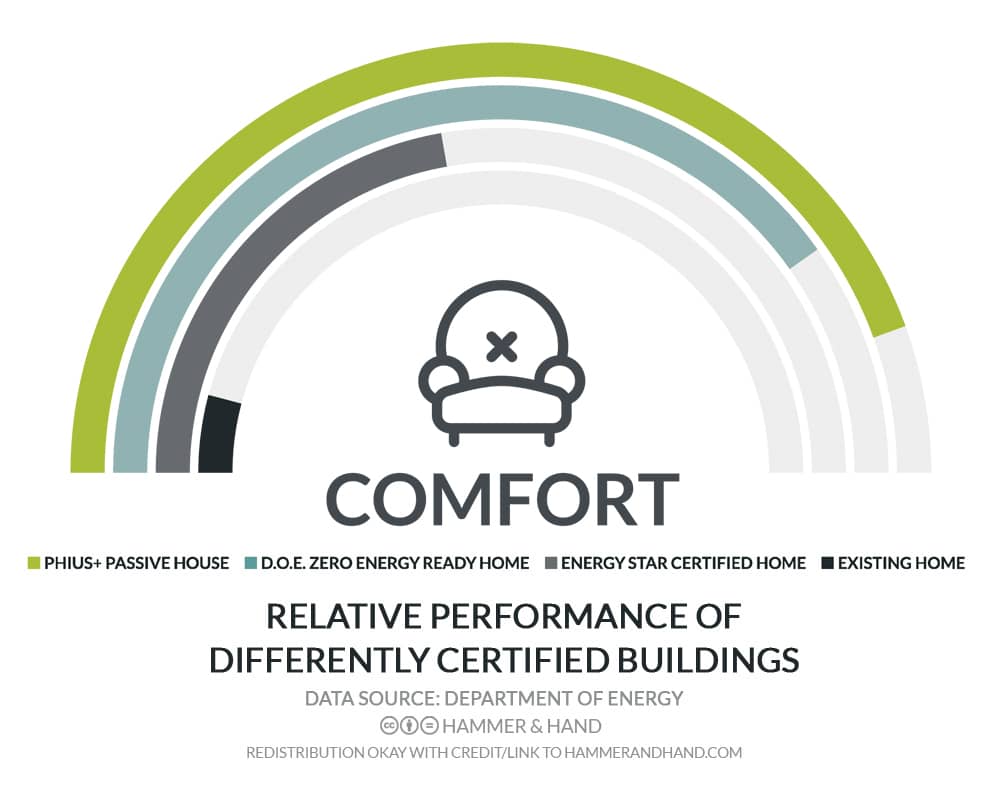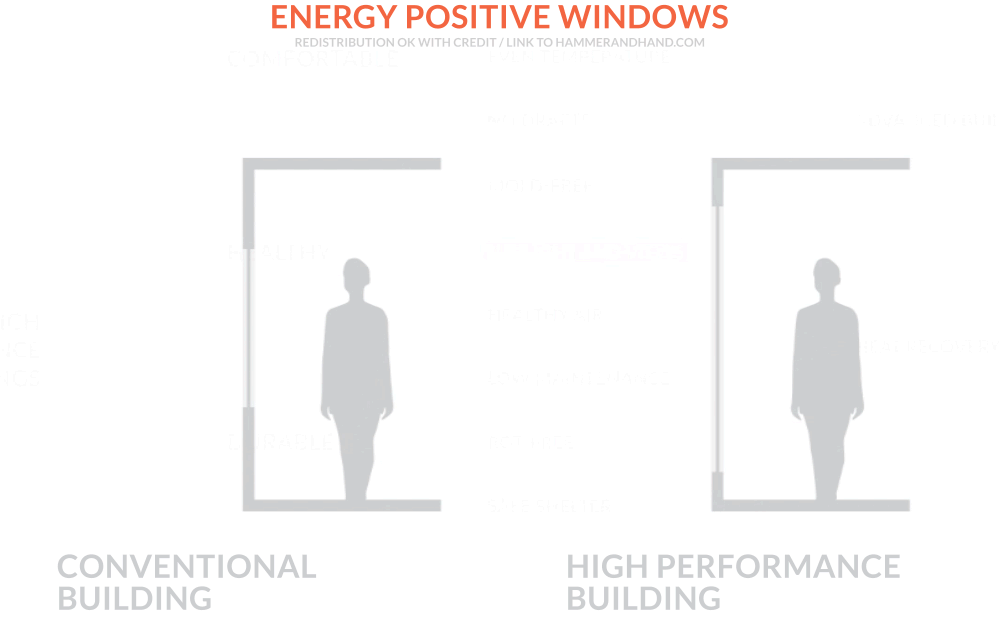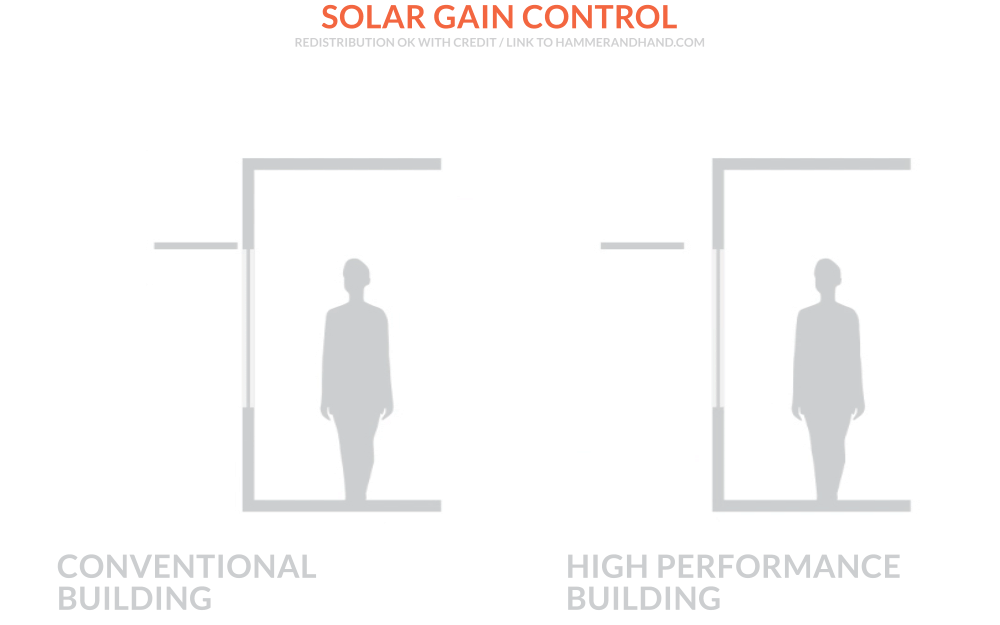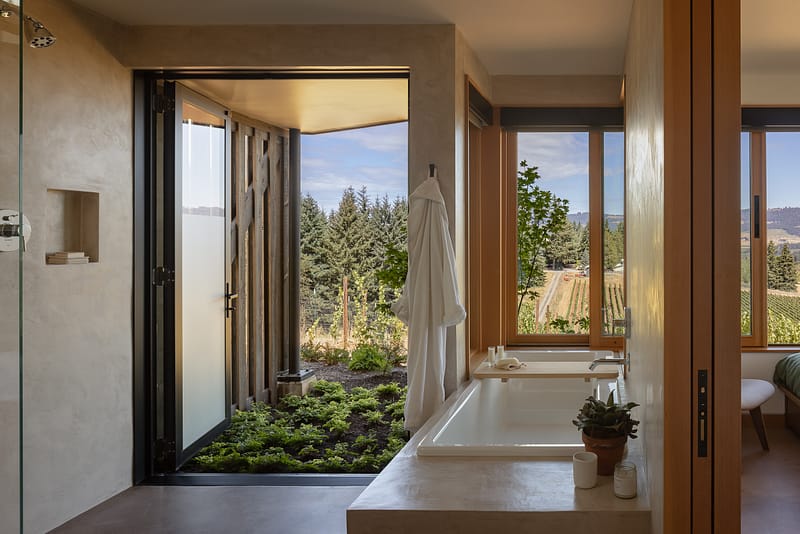High performance passive buildings are designed and engineered for comfort. They are quiet, draft free, and cozy, enclosed in an evenly warm building envelope.
Unlike conventional buildings that rely on energy-intensive mechanical equipment to blast hot or cold air to compensate for uncomfortable design flaws – design flaws that we have all taken for granted as “normal” – high performance buildings address comfort through their very construction.
 The image above shows the US Department of Energy’s assessment of the levels of comfort delivered by high performance Passive House buildings, DOE Zero Energy Ready Home, Energy Star buildings, and conventional buildings. According to DOE, the comfort delivered by high performance buildings is dramatically superior.
The image above shows the US Department of Energy’s assessment of the levels of comfort delivered by high performance Passive House buildings, DOE Zero Energy Ready Home, Energy Star buildings, and conventional buildings. According to DOE, the comfort delivered by high performance buildings is dramatically superior.
Why?
The first answer is that high performance buildings are comfortable because they are built airtight. (Worried about indoor air quality? Read here about the fresh air ventilation strategies that provide superior air quality to high performance buildings.) By controlling the movement of air, we are also controlling the movement of heat and moisture, two fundamental determinants of human comfort. Nobody enjoys a damp, cold draft on a blustery winter day. Airtight construction eliminates the air leaks that rob structures of comfort.
 The next contributor to the comfort of high performance building is thermal bridge-free construction. A thermal bridge is any building element that cuts across a building’s insulation (or “thermal envelope”) and facilitates the transfer of heat between inside and outside. Thermal energy is so good at finding the path of least resistance that thermal bridges can become superhighways of thermal loss from a building and make interior surfaces cold and uncomfortable. By carefully detailing building assemblies and wrapping the exterior of buildings with continuous, monolithic insulation, high performance building designs can eliminate these energy-sapping thermal bridges.
The next contributor to the comfort of high performance building is thermal bridge-free construction. A thermal bridge is any building element that cuts across a building’s insulation (or “thermal envelope”) and facilitates the transfer of heat between inside and outside. Thermal energy is so good at finding the path of least resistance that thermal bridges can become superhighways of thermal loss from a building and make interior surfaces cold and uncomfortable. By carefully detailing building assemblies and wrapping the exterior of buildings with continuous, monolithic insulation, high performance building designs can eliminate these energy-sapping thermal bridges.
Our goal is to thermally isolate, or “thermally break,” the building’s interior from the outside environment. A uniform thermal break with superinsulation helps to create even interior surfaces temperatures in a building, a key component to occupant comfort. The human body is a terrifically sensitive sensor of hot and cold surfaces nearby (radiant temperature), so even if air temperatures are at 72 degrees a cold wall will still make you feel chilly. The natural occupant response? Crank up the thermostat and burn energy blasting warm air into the building. But that mechanical response doesn’t address the cause of the discomfort. By providing even, warm surface temperatures, high performance envelopes address the problem at its root through passive means.

These even conditions also help establish even ambient air temperatures in a building. Because warm air rises and cold air falls, the uneven surface temperatures and leaky envelopes of conventional buildings means that air at head level can be too warm while air at your feet is too cold. Or the air on the second floor is unbearably warm while the ground floor is chilly. The natural occupant response? Crank up that thermostat, maybe open up a second story window. Again, this not only wastes energy, it doesn’t address the cause of the problem. High performance buildings and their even surface temperatures provide constant, comfortable air temperatures throughout the building.

High performance buildings are also draft-free. They accomplish this partly through the airtight construction that eliminates air leaks through the building envelope. But even an airtight building can be drafty. How? Convection currents caused by cold interior surfaces, like a mediocre window. Warm interior air will hit that cold surface, cool, drop, skid out along the floor, warm back up, rise, hit the windowpane again, and repeat the cycle. Behind every poor window you’ll have a nice draft established. Even if interior temperatures are at 72 degrees, you’ll be uncomfortable with that draft on the back of your neck if you’re sitting next to a window. High performance buildings with good windows solve this problem.

Comfort has a powerful visual component, as well. Access to views outside and natural daylight is key to occupant happiness, especially in the Pacific NW. Contrary to popular myth of the Passive House as windowless “thermos,” high performance buildings and generous glazing go hand-in-hand. In fact, when deployed smartly, high quality windows are often “energy positive,” meaning the daylighting benefits and passive solar gains captured by the windows are more than offset by any thermal loss out of them.

These energy positive windows do raise the potential for overheating during certain hours of the day, certainly in summer but even in spring and fall when temperatures are mild but the sun’s low angle brings in lots of passive solar gain. That’s why solar management (eg. operable exterior shades) should be part and parcel of most high performance buildings. That way the building can capture passive solar energy when needed and shield it when not.

All these strategies come together to elevate occupant comfort to levels that are simply in a different league than those we experience in “normal” buildings. These buildings are built for comfort.
Here’s what the owner of Pumpkin Ridge Passive House has to say about his experience:
“When you put a little more thought and a little more attention into the engineering of the house, you have a house that’s really comfortable, that you really enjoy, that you can stay in for the rest of your life and that you don’t want to leave. I don’t know that I can say that for any other houses that I’ve lived in.”
Featured image from Madrona Passive House, designed by SHED Architecture.




